
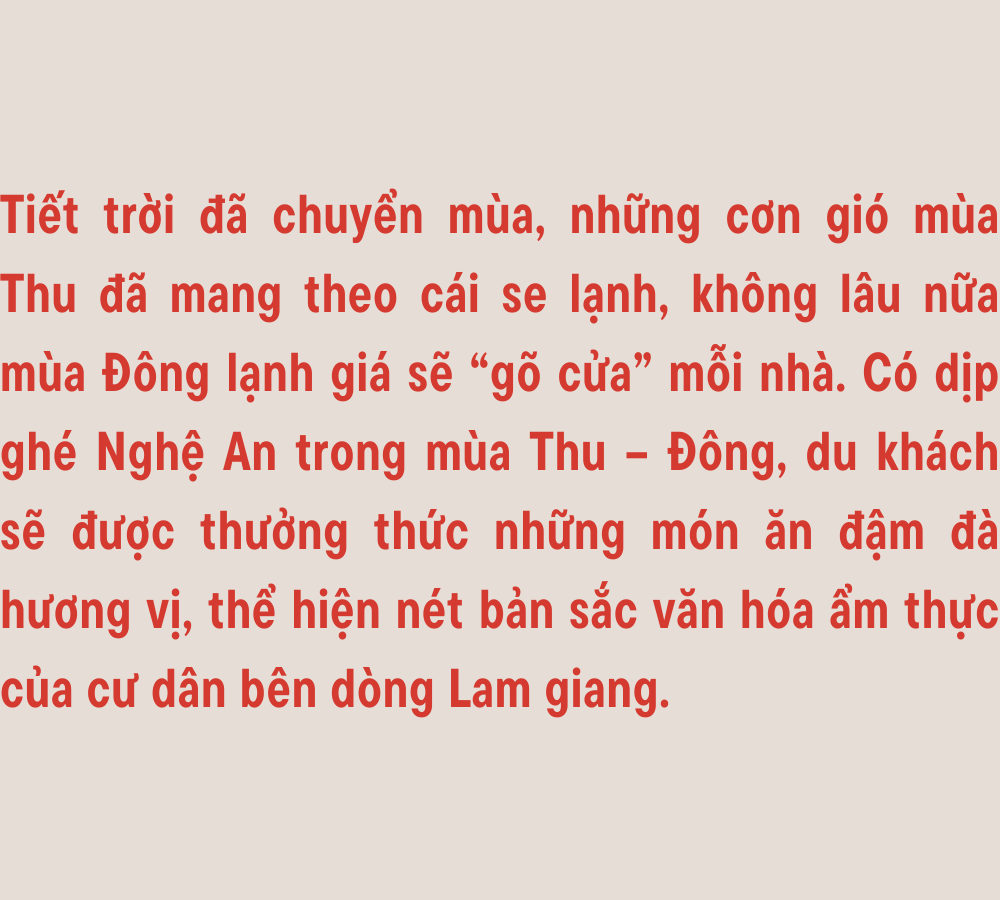
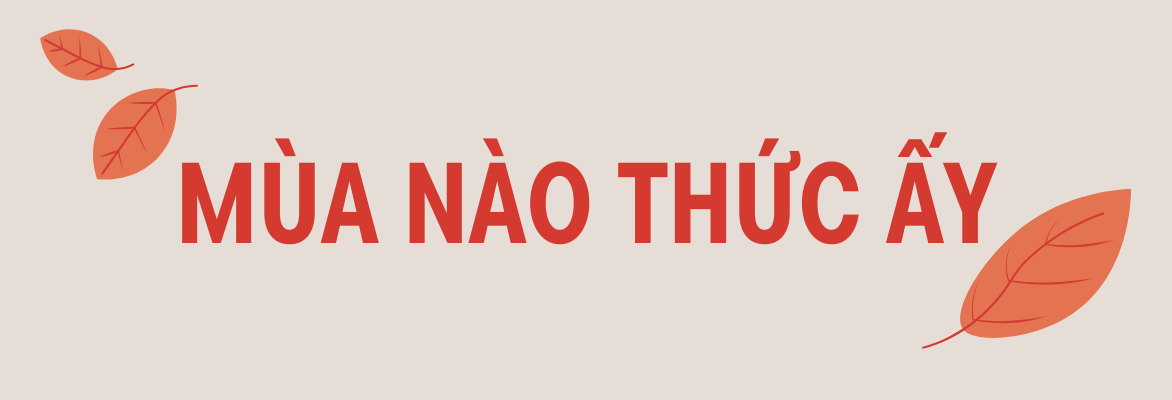
In the minds of people everywhere, Nghe An is a dry, harsh land like the lyrics of a song.“Winter is freezing cold/Summer is scorching hot/The fields are dry and cracked/The rain never comes back…”.From that arid and harsh environment, many generations have risen up to help life, becoming heroes and great men whose names have been recorded in history, contributing to making Nghe An a land of "spiritual land and talented people".
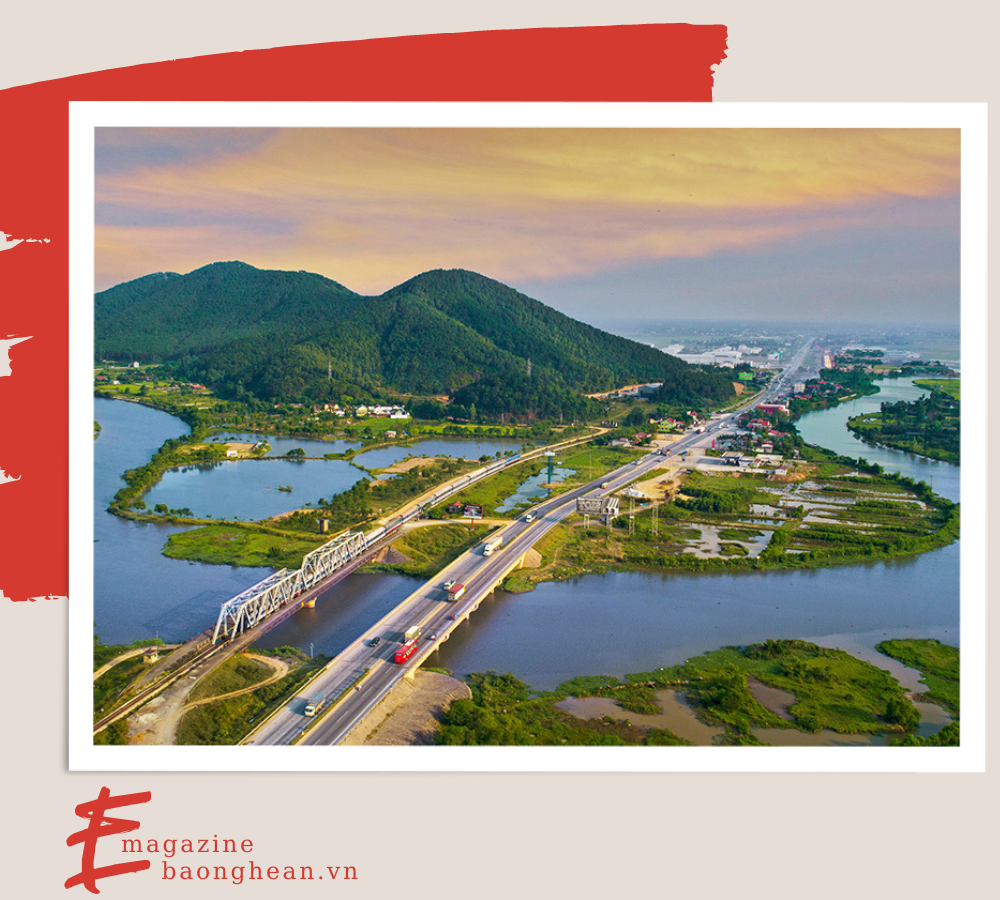
And to survive in the "freezing weather" and "burning sun", Nghe An people have collected ingredients from fruits and animals around them to process into dishes that ensure energy to serve the needs of life. Through the process of transformation and adaptation, besides the common dishes, there are dishes that have become specialties, representing the culinary culture of the homeland.
Each season has its own food, the harshness and extremes of the weather force Nghe An people to choose dishes that suit the characteristics of each season. In the cold season, grilled and braised dishes are often preferred by people, because they bring to the eater a feeling of warmth, heat and more energy. Therefore, coming to Nghe An this season, from coastal fishing villages, hamlets, villages in the plains, midlands to villages, villages in the mountains, highlands, visitors will enjoy products with their own flavors, not easily mixed with other regions.

Let’s start from the coastal countryside. Coming to the sea this season is not to immerse yourself in the water or play with the waves, but to enjoy attractive dishes at quite “soft” prices, which are not easy to find during the peak tourist season. The fishing villages in Cua Lo, Nghi Loc, Dien Chau and along Quynh beach this season are still bustling with boats coming and going, with fish, shrimp, squid, and crabs still filling the holds.
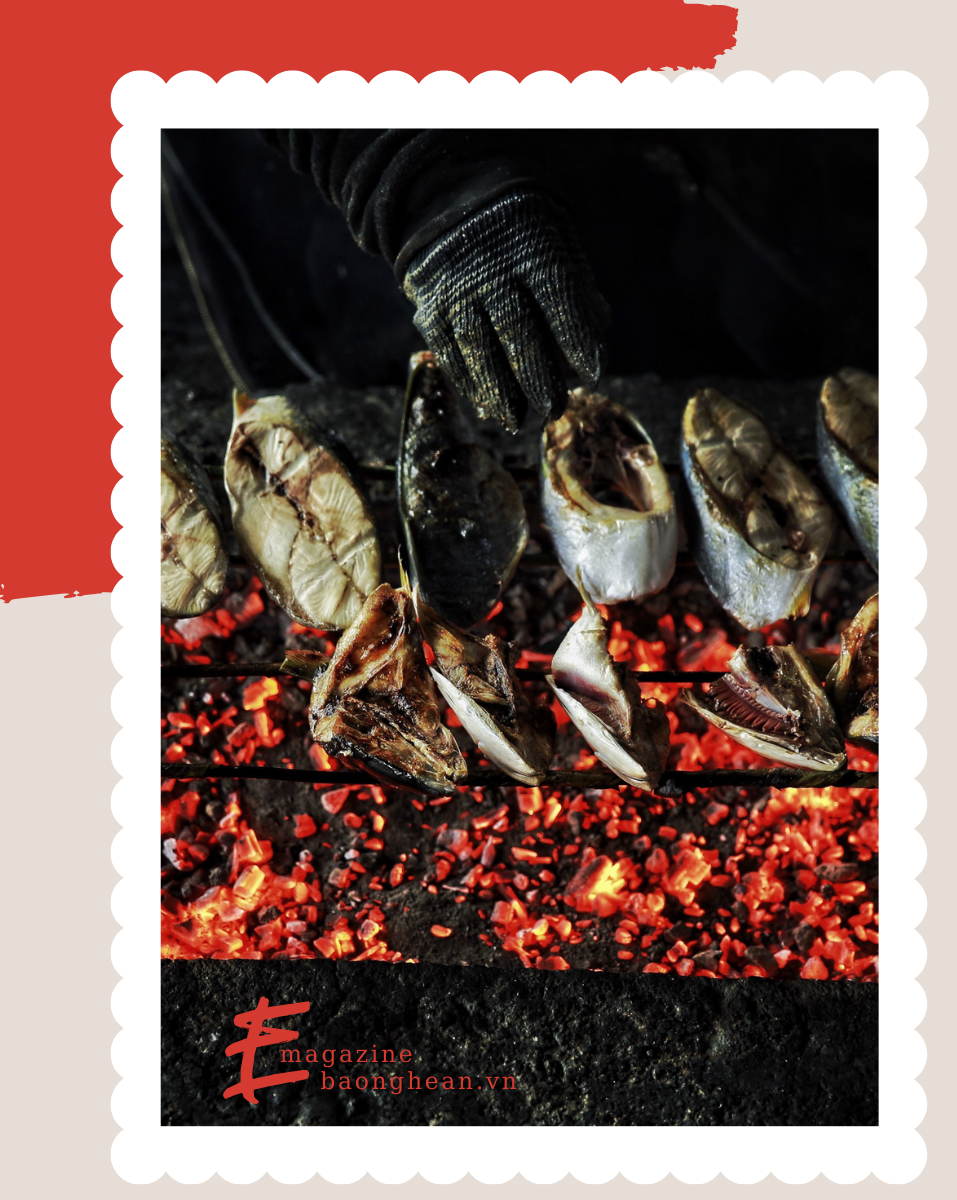
The fishermen’s favorite dish on cold days is steamed squid and steamed crab. Fresh, live squid and crabs brought back from the open sea are cleaned and steamed with aromatic and spicy spices. When cooked enough, the aroma spreads throughout the space, making diners want to enjoy the hot squid and crab, eating and exclaiming. The salty taste of the sea mixed with the spicy, strong taste and aroma of spices will help diners feel the attraction of the “gift of the sea”.
This season, the coastal village also has an equally attractive grilled mackerel dish. Freshly brought back from the boats returning from the open sea, the plump mackerels are cut into pieces, arranged on grills and then placed on a glowing charcoal stove. People use fans to let the heat of the charcoal gradually penetrate into each fiber of the mackerel until it is evenly cooked, fragrant and delicious.
Grilled mackerel can be eaten fresh from the grill. Tourists often go to grilled mackerel spots in Cua Lo to enjoy with drinks. Grilled mackerel can also be stored for many days to be used in meals. Tourists often buy grilled mackerel in bags and vacuum-sealed as gifts for friends and relatives.


From the coastal villages, if you have time, visitors can continue to the districts in the plains and midlands to enjoy Nghe eel - a famous specialty in all regions. Eels live in the fields in all regions of the country, but Nghe people have accumulated their own secret to create a unique flavor, becoming a specialty.
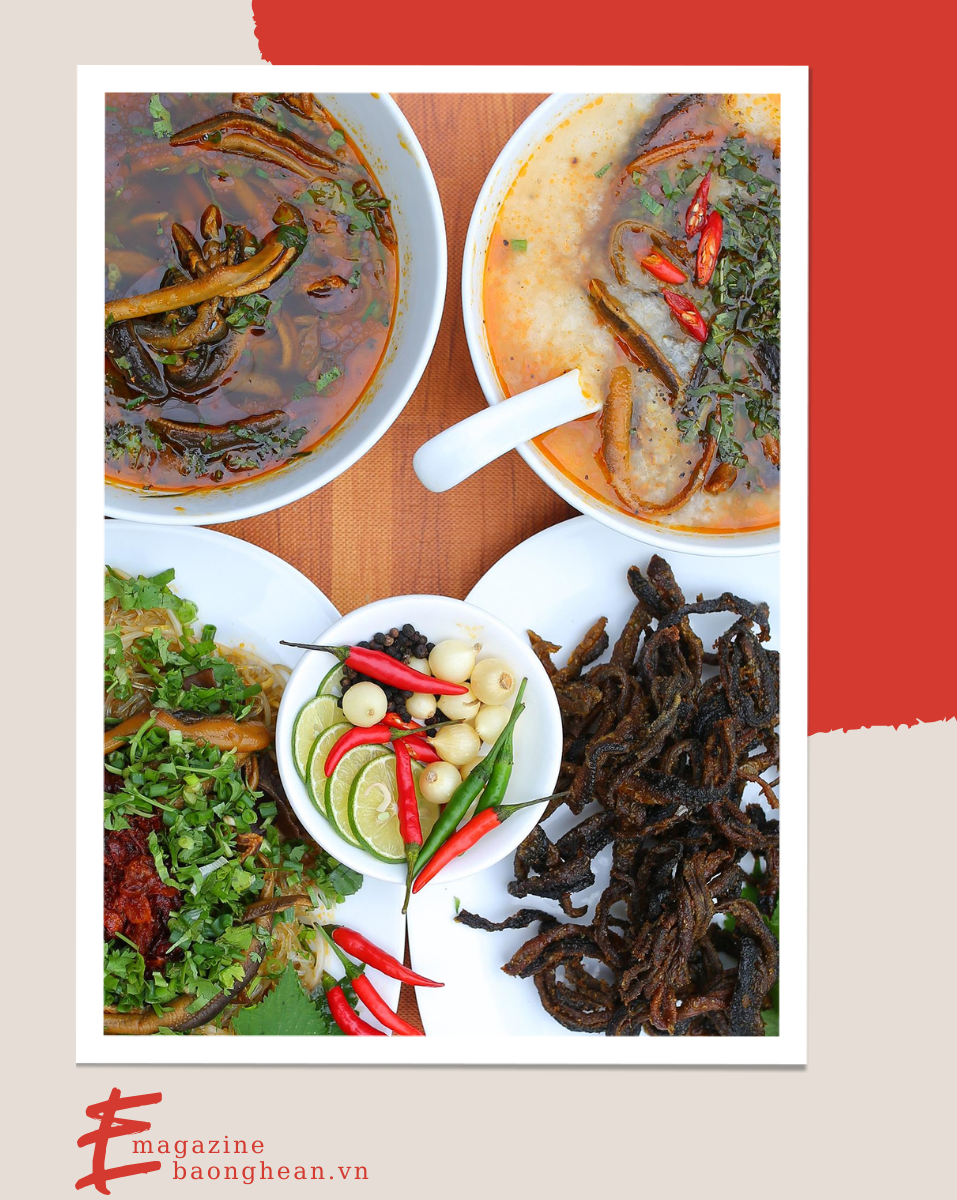
Eels can be processed into dozens of dishes, the most popular being eel porridge, eel soup, braised eel with banana, stir-fried eel with lemongrass and chili, eel rolled in betel leaves... In particular, eel porridge and eel soup are sold a lot in Vinh city, Quynh Luu, Yen Thanh, Dien Chau, Hung Nguyen... Gourmets, whenever they have the opportunity to pass through or return to Nghe An, stop to enjoy a bowl of hot eel porridge or eel soup. The spicy, fatty taste makes the dish more attractive, helping diners to regain energy and stay healthy throughout the journey.
Currently, some eel dishes in Nghe An have been packaged and vacuum-sealed, ensuring quality and hygiene, convenient for long-distance transportation. Therefore, tourists can bring the taste of Nghe An countryside to all regions for relatives and friends to enjoy.
While writing this article, we received good news: At the end of August, when Thanh Chuong pickled vegetables and Cua Lo fish sauce were selected into the top 100 outstanding Vietnamese specialty gifts (2021 - 2022), Nghe An's eel soup with bread and Vinh wet cake were also honored to be in the top Vietnamese specialty dishes. This is the pride of the "Lao wind, white sand" countryside, increasing the trust of friends and tourists from all over the country in Nghe An's specialties.

The midlands and plains of Nghe An also have many famous dishes such as goby fish, mountain goat, veal, hill chicken... Goby fish is caught from Lam River and processed by stewing with spices such as pepper, turmeric, ginger, soy sauce, galangal and stewed with pork belly. Each stewing method will have a typical dish, all have in common the spicy, hot and salty taste, very suitable for cold meals. Braised goby fish is sold at many restaurants in Anh Son, Do Luong, Thanh Chuong districts...
Veal ham is a specialty of Nam Dan, made from whole veal ham marinated with spices such as fish sauce, pepper, and eggs. Then, it is rolled up, wrapped in leaves, and steamed in a cast iron pot, boiling for about half a day. With this cooking method, veal ham retains the flavor of veal and the aroma of spices. Veal ham is often displayed on trays, feasts on holidays, New Year, weddings, and death anniversaries and can be stored for a long time. Recently, veal ham has been favored by many tourists and chosen to buy as gifts...

At the end of the year, the pace of life in the highland villages of Nghe An is slowing down, because the fields have been harvested, and the rice and corn have been brought home. The weather at the end of the year here clearly has the characteristics of the dry season, with temperatures dropping quite low but almost no rain. These weather conditions are truly ideal for trips to explore and experience the lives of ethnic minorities in the highlands.

Coming to Con Cuong, Tuong Duong, Ky Son, Que Phong and Quy Chau, visitors will be immersed in the space of mountains, forests and villages, exploring the cultural life of indigenous people. And once here, visitors cannot help but enjoy the highland products, so that when leaving, they cannot help but feel nostalgic and lingering.
Traditional dishes that have become specialties of the highlands are five-color sticky rice and bamboo rice. These dishes are made from upland sticky rice and leaves and forest trees, attractive for their stickiness, fragrance and impressive colors. Through that, they show the ingenuity and sophistication of highland women, especially Thai women.
Five-color sticky rice and bamboo-tube rice are often served with grilled dishes, which are also specialties of the mountainous region. Dishes such as black pig, black chicken, and stream fish are grilled on a glowing charcoal stove, the fragrant aroma spreads with the wind, and even before eating, diners can feel the attraction of the flavor. Besides, dishes prepared in the "giang" way - hung on the kitchen roof - are equally attractive.
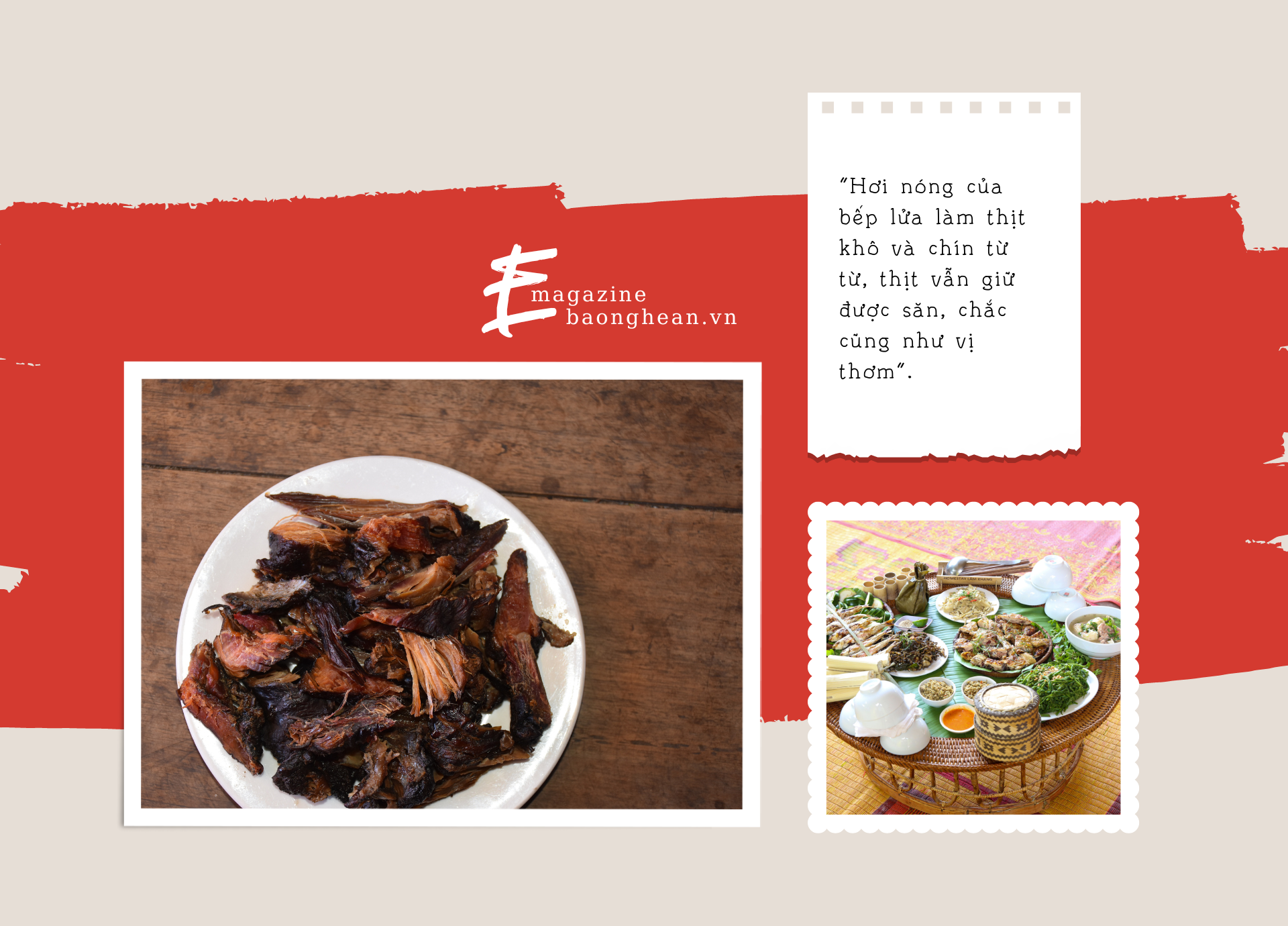
Beef, buffalo, pork and fish are cut into hand-sized pieces, marinated with spices (fish sauce, pepper, ginger, garlic) and then hung on the stove. The heat from the fire dries the meat and cooks it slowly, the meat still retains its firmness and aroma. When serving, just grill the meat on the stove, then visitors will enjoy a very special dish, imbued with the flavor and identity of the highlands. In the cold weather, sitting by the fire with specialties and sipping a glass of wine made from leaves, it seems like there is nothing more interesting in this life.
Western Nghe An has now built many community tourism spots. Tourists can go to Khe Ran village, Bong Khe commune; Nua village, Yen Khe commune; Xieng village, Mon Son commune (Con Cuong); Quang Phuc village, Tam Dinh commune (Tuong Duong), Muong Long commune (Ky Son), Hoa Tien village, Chau Tien commune (Quy Chau) or Long Thang village, Hanh Dich commune (Que Phong) to experience the culinary culture of the highlands of Nghe An.
